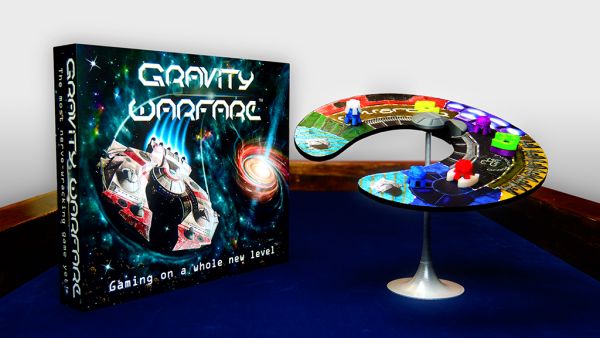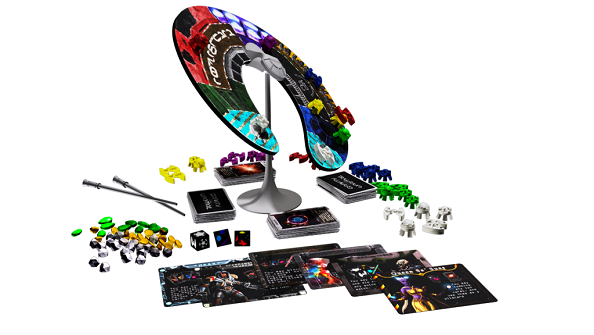Dexterity, Take-That, and a Rotating Platform in Gravity Warfare: A Kickstarter First Look

Can you place your piece on a spinning platform? How about stacking on a second piece while only holding it with a pair of chopsticks?
Gravity Warfare is a dexterity game, currently seeking funding on Kickstarter, that features a board that’s both creative and arresting.
Gameplay
Gravity Warfare features a horseshoe-shaped platform that can be spun and tilted. The goal of the game is play all your pieces before the other players do. While the winning conditions are up to the players, the rulebook recommends either the player with the highest score after three matches or the first to twenty points.
Each player starts the game with five points, a hero card (each hero has a special ability that can be used once each match), and a guardian card. A guardian card can also only be used once each match, and when played allows you to take your turn as you wish, ignoring any dice rolls, event cards, or challenge cards played that turn. Finally, each player is dealt five additional cards (the maximum hand size throughout the game is six).
At the start of your turn you roll two dice. One relates to the eight locations on the platform and one relates to your game pieces. What you roll dictates which piece you will be placing and where. If you roll a piece that you are now out of, you may roll a second time. If you still roll a piece you no longer have, you take a green gem and your turn ends. Green gems can be spent on future turns to allow you to use any piece.
After you roll the dice and everyone knows which piece you will be placing and where, your opponents may choose to play challenge cards. Each player may play one challenge card per turn. These will make placing your piece more difficult. It may require you to place it while the platform spins or force you to use the chopsticks included in the game. More than one challenge card can affect your turn at a time; so, for example you may have to place a piece on top of an already placed piece while the platform is also spinning. Players can also use event cards which lets them do such things as remove pieces from the platform. You may not play challenge or event cards on your own turn.
There are two ways to draw more cards. If you successfully complete your turn when one or more challenge cards have been played, you may draw two cards, keep one, and discard the other. Alternatively you may spend one point to do the same. You may do this multiple times in a row if you have the points to spend.
If you stack a piece on top of one or more pieces, and a challenge card did not force you to do so, you score one point for each piece yours is stacked on top of. If, on your turn, three or fewer pieces fall off the platform, you must take back any pieces which belong to you and the rest are set aside. If four or more pieces fall, the match ends, you lose two points, and the other players score points based on how many pieces they still have. If the match did not end this way, the first player to play their last piece on the platform scores five points and ends the match.

First Impressions
Gravity Warfare immediately catches your eye and stands out with its platform. It appears to be sturdy and to hold together well while it spins and tilts, and the rulebook assures you that as long as it's treated well, it’s not going to fall. The platform is also double-sided so you can either be fighting across planets and galaxies or onboard a mothership. While this doesn’t change gameplay, it does add some nice adjustable flavor to the game.
It’s also nice to have a dexterity game that isn’t about flicking, throwing, or tossing anything. While all of those mechanics can be a lot of fun, some people struggle with them more than others, and Gravity Warfare involves a different kind of dexterity, as you carefully place the pieces on the right areas of the platform, while adapting to the challenge cards that are thrown your way. As more pieces are placed on the platform, the risk of tilting and pieces falling increases, so the stakes should also increase as the match progresses.
The challenges look like they combo nicely, and the rulebook stresses the importance of these challenges over your dice rolls. If for some reason the challenge cards your opponents play on you can’t be completed with your current roll results, you roll again. Opponents are also allowed to openly discuss what cards they are going to play.
A team mode is also included in the rules, which includes the intriguing suggestion that players can play cards on their own teammates to help them run out of pieces faster.
Typically, I prefer games to give definite win conditions rather than leaving it up for players to agree on, but Gravity Warfare seems very much like a game where winning will be secondary to the fun of trying to meet challenges and giving other players difficult tasks.
From a unique game board to dexterity mixed with some take-that, Gravity Warfare looks highly enjoyable and entertaining. Check it out on Kickstarter and see for yourself if it’s a good fit for you.




